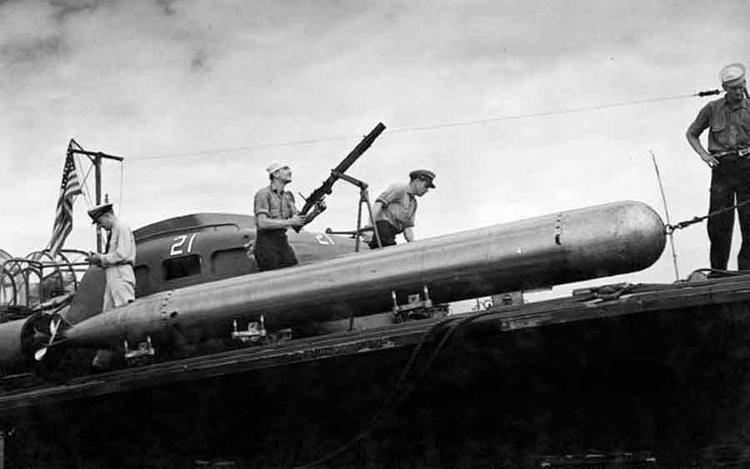Place of origin United States | In service 1911–1945 | |
 | ||
Used by | ||
The Bliss–Leavitt Mark 8 torpedo was the United States Navy's first 21-inch by 21-foot torpedo. Although introduced prior to World War I, most of its combat use was by PT boats in World War II. The torpedo was originally designed in 1911 by Frank McDowell Leavitt of the E. W. Bliss Company and entered full mass production in 1913 at the Naval Torpedo Station in Newport, Rhode Island. It was deployed on destroyers and battleships during World War I and cruisers built in the 1920s. All US battleships and most cruisers had their torpedo tubes removed by 1941. The Mark 8 remained in service through World War II on older destroyers, primarily the Wickes and Clemson classes. It also equipped PT boats early in World War II, but was replaced by the Mark 13 torpedo on most of these in mid-1943.
Contents
Under the Lend-Lease Act, about 600 Mark 8 torpedoes were issued to the United Kingdom for use with 50 pre-1930 destroyers it received under the Destroyers for Bases Agreement.
Design
The design was originally intended to be used on destroyers in an anti-surface ship role. When it was first released, it was a highly advanced torpedo, but when it was actually deployed into service during World War II it was showing its age and unable to compete with modern torpedo technology. The low speed of the torpedo was one of the complaints; its Japanese counterpart, the Type 93 torpedo, was significantly faster and more difficult to spot in the water.
Deployment difficulties
The Mark 8 had many technical difficulties with its design that would be a bane to the torpedomen who would use them. The first issue came with the process of simply launching the torpedo, which was fraught with its own set of difficulties. The gyro in the torpedo was sensitive when it was first launched and it would need to be launched from an even keel, otherwise the torpedo would lose stability when it hit the water. The other issue concerned the launching mechanism. The initial system was set with a black powder charge to push the torpedo out of the tube. This was a problem in the South Pacific, where the humid climate would cause these charges to misfire, sometimes not putting enough force behind the torpedo to fully eject it from the tube. One other risk of these misfires was what is called "hot running", where the torpedo would run in its tube. Though the warhead could not detonate, the motor would overheat and explode without water to cool it, sending splinters across the deck. Another issue was that the tubes were heavily lubricated with oil and grease to ensure that the torpedo was launched from the tube correctly. The problem became that sometimes during the launching, the charge would ignite the grease and oil in the tube causing a fire that would emit a dark black smoke that would immediately give up the location of the torpedo boat, reveal the point where the torpedo was coming from and allow the enemy to take action to avoid it.
The torpedo also lacked the explosive power of newer models. It carried less than 500 pounds of TNT-based explosives, which was far from a guaranteed ship kill on strike. This would frustrate many captains who, when lucky enough to hit an enemy dead on, would have the warhead go off but not do enough damage to sink the target, and allowed many of them to escape.
